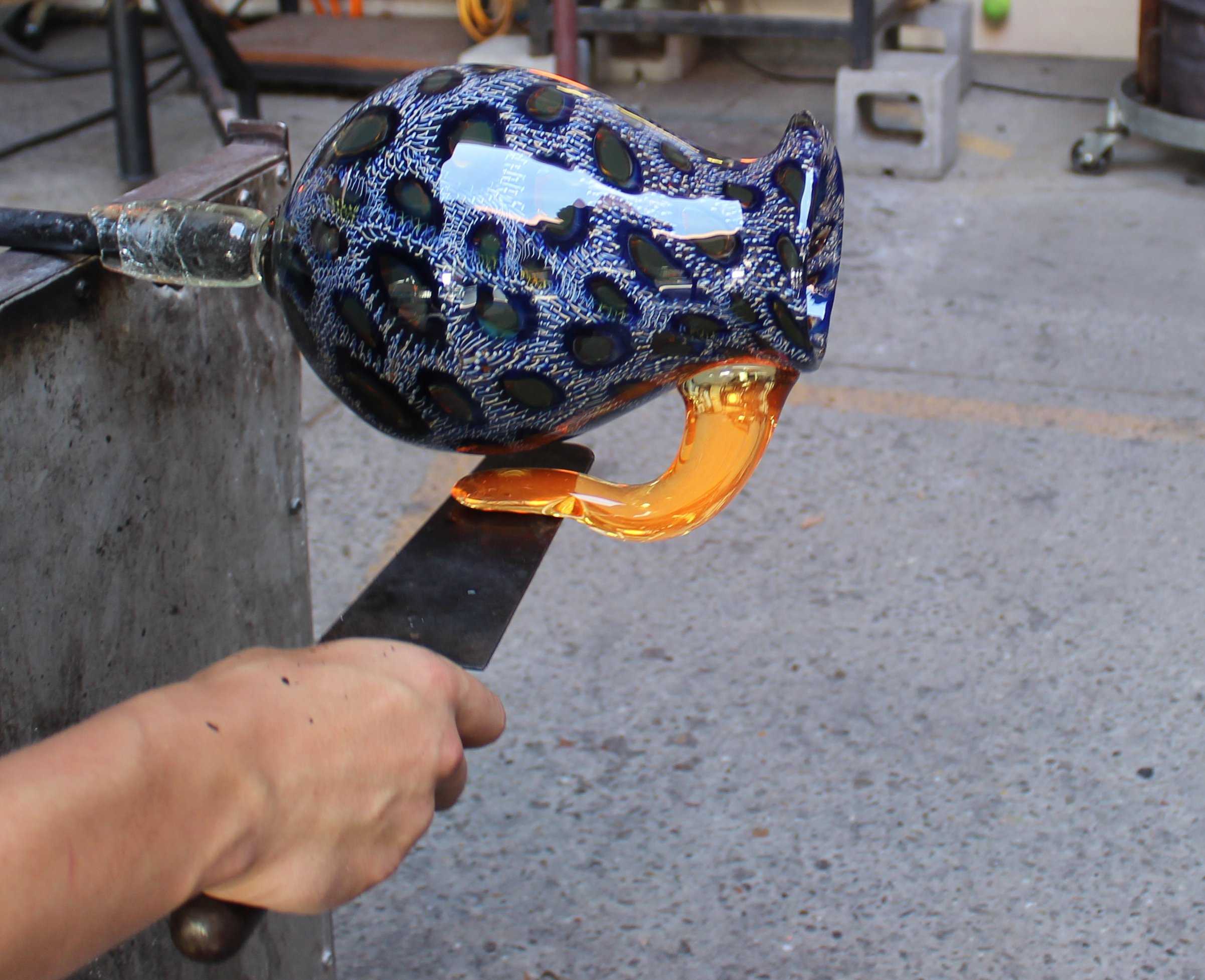
Once heated to 2,000 degrees Fahrenheit in the blazing inferno of a furnace, glass becomes liquid, now malleable enough to be formed into the spray of a wave, the gentle curve of a duck-bill or even the intricate spiral of a snail shell. Despite the unique opportunities that glassblowing offers students, Palo Alto High School is one of only four high schools in the nation to offer a glass blowing program due to its inherent danger and annual operating budget of $50,000.
The fuel and electricity required to keep the furnace running at 2,300 degrees Fahrenheit all day, the large volumes of glaze and glass coloring needed to stain the glass and the massive amount of molten glass that students use contribute to the exorbitant annual cost of the program.
Although the cost is high, Glassbowing Instructional Aide Dana Rottler believes that the medium offers students the rare ability to artistically express themselves in a non-traditional way.
“Glass is different because of its fluidity,” Rottler said. “Every exact move you make is represented in the glass and your emotion transports through to the final piece.”
Glassblowers begin their creations by dipping a hollow metal rod into a furnace containing liquid glass, which anneals to the end. The blazing hot lump of glass is removed and students blow into the opposite end of the hollow rod, expanding the glass. As the glass cools to 1500 degrees, students use a variety of tools to shape it into a rough cylinder during the most dangerous part of the glass-blowing process, as people are most likely to burn themselves here.
For junior Ben Beaudry, the aspect of danger is what differentiates glass blowing from other art classes and opportunities offered at Paly.
“In glass blowing, there are no limits as long as you set your mind to it.”
Ben Beaudry, junior
“The danger involved makes it fun,” Beaudry said. “If you mess up you might hurt yourself or even other people [which is] what makes glass blowing stand out from other forms of art.”

Students have limited time to shape their creations — as the glass cools it becomes less malleable and harder to work with. They then have to put their object into a miniature furnace dubbed the “glory hole,” which runs at 2,300 degrees Fahrenheit and quickly heats the glass back up.
Students switch between the searing heat of the furnace and intricate design work that must be completed as quickly as possible without touching the scalding glass. When they are satisfied with their design, the object is placed in an annealer, an insulated box that cools the glass slowly overnight.
“Some materials are more forgiving, whereas glass is set the moment you touch it,” Rottler said. “It’s a frozen, timeless material that will never change or fade.”
After cooling, students sand off excess glass chips using sandpaper and water, and polish their pieces using a high-speed sander. The entire process, beginning with a lump of glass and culminating in an intricately detailed piece of art, takes only two days.
Glassblowing is offered as part of the larger Ceramics and Sculpture/Advanced Sculpture classes at Paly. However, the short creation time and high-risk, high-reward style makes glass blowing the most unique art form.
The effects of student choices are dramatic, exciting and often dangerous — quite different from the subtle iterations involved in traditional art forms such as drawing, painting and sculpture.

“Glass blowing is a really great way to express yourself because you can make whatever you want,” Beaudry said. “There are no limits as long as you set your mind to it.”
As students walk the line between safety and danger, masterpiece and deformed scrap, they learn patience, perseverance and caution — valuable traits that can be applied to activities outside of art.
“I’ve spent a lot of time on a really cool piece only to break it in the final moments,” junior Evan Welsh said. “You definitely learn perseverance and how to handle disappointment.”
To offset the large annual budget of the program, students try to be as conservative as possible with the glass they do not use, melting scrap glass for reuse. In addition, the Paly Fiery Arts Boosters Club works to ensure the program has sufficient funds to continue, through annual fall and winter sales of over 800 handcrafted glass pieces. The glass pieces contributed by Paly instructors, students and alumni cover most of the annual budget.

Glass blowing is easily accessible to students with no sculpting experience, as creating simple but aesthetically appealing designs is fairly simple. However, the range and complexity of projects scales quickly as students gain more knowledge. The more students learn, the more they can do — some students make their own molds using special clay and their own colors using a blend of different metals.
Art is a medium through whch students can express themselves, and hopefully change the views of others in the process. Glass blowing gives students who lack traditional art skills this powerful ability.
“The purpose of art is to allow yourself self-expression while sharing your thoughts, beliefs and feelings with the world in hopes to change it and make it a better place,” Rottler said. “Glass is a mesmerizing material that students can become super passionate about.”
“Glass is different because of its fluidity. Every exact move you make is represented in the glass and your emotion transports through to the final piece.”
Dana Rottler, Glassblowing Instructional Aide




Rachel Lannister • May 8, 2017 at 10:08 am
Thank you for the very informative article. I particularly liked what you said about how it takes temperatures of over 2,300 degrees to properly blow glass. I had heard that the glass blowing required quite a few different things to do it properly. When dealing with temperatures that high, it would make sense that you would want proper equipment to stay safe. I’ll have to look online see what exactly those materials are.